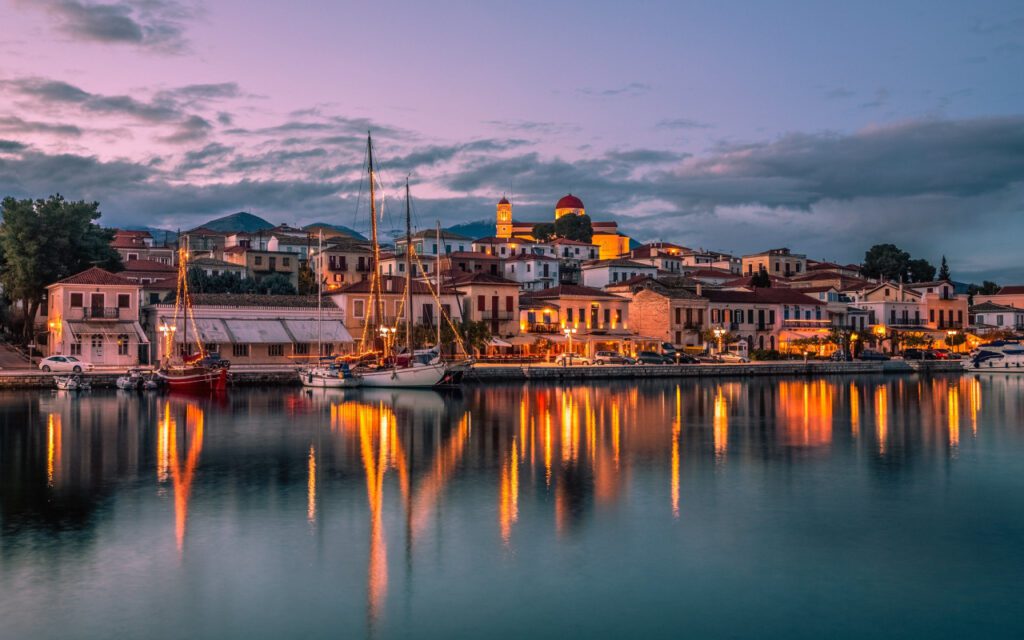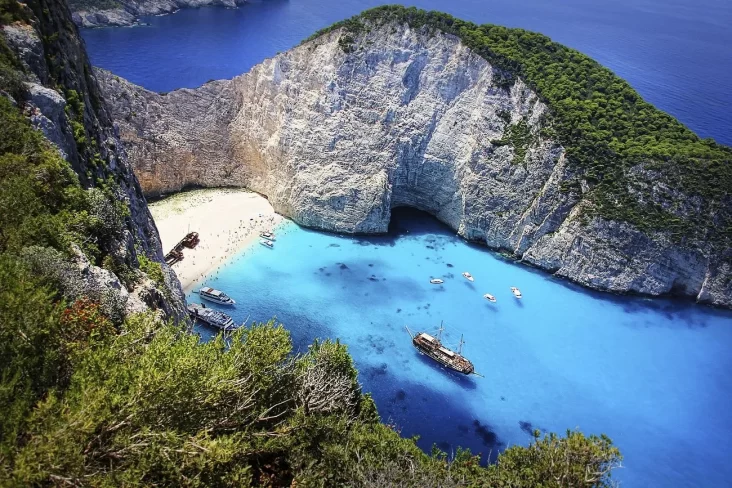Greece, with its stunning islands, ancient ruins, and Mediterranean charm, beckons travelers year-round. But when exactly is the best time to visit Greece? With such geographical diversity—from the sun-soaked Cyclades to the verdant Ionian islands and the historically rich mainland—timing can significantly impact your Greek experience.
TL;DR: Generally, the best times to visit Greece are the shoulder seasons (April-June, September-October) for excellent weather, fewer crowds, and reasonable prices. Summer (July-August) is hot and crowded but perfect for beach enthusiasts and island parties. Winter (November-March) offers great deals and authentic experiences in cities, though many island facilities close and weather can be cool and rainy.

Understanding Greece’s Seasons: Pros & Cons
Visiting Greece in Spring (April – June)
Spring transforms Greece into a colorful paradise with wildflowers blanketing the countryside and temperatures rising pleasantly day by day. The Aegean and Ionian waters begin warming up, though they might still feel brisk until late May.
Weather: Mild and increasingly warm (15-25°C), with occasional rainfall diminishing as summer approaches. Athens and the southern islands warm up earlier than northern regions.
Crowds: Tourist numbers build gradually, with a noticeable increase around May. Early spring feels refreshingly local, while June begins to buzz with pre-peak energy.
Prices: April and early May offer excellent value before the summer premium kicks in. Accommodation rates in June begin climbing toward peak season levels.
Best Activities:
- Hiking ancient paths with perfect temperatures
- Exploring archaeological sites without summer heat
- Early island hopping (though some facilities may still be opening)
- Experiencing authentic Greek Easter celebrations (dates vary)
Who is it best for? Culture enthusiasts, active travelers, photographers, and those seeking authenticity without winter’s limitations.
Key Takeaways:
- Easter in Greece is a magnificent cultural experience (often in April/May)
- Islands are awakening but not yet at full capacity
- Perfect balance of good weather and manageable crowds
- Ideal for exploring both mainland and islands
Visiting Greece in Summer (July – August)
Summer brings Greece’s iconic postcard weather—brilliant sunshine, cloudless blue skies, and warm seas perfect for swimming. This is when the Greek islands truly come alive.
Weather: Hot and dry (25-35°C), with reliable sunshine. Occasional meltemi winds provide relief in the Cyclades but can disrupt ferry schedules.
Crowds: Peak season brings throngs of visitors to popular destinations. Santorini’s sunset spots, Mykonos beaches, and the Acropolis become significantly crowded.
Prices: Premium rates apply everywhere, with accommodation prices sometimes doubling compared to off-season. Advance booking is essential.
Best Activities:
- Beach life and water sports
- Island hopping with maximum connections
- Vibrant nightlife and summer festivals
- Sunset sailing cruises
Who is it best for? Sun worshippers, social butterflies, nightlife enthusiasts, and families constrained by school holidays.
Key Takeaways:
- Guaranteed perfect beach weather
- Island infrastructure fully operational
- Lively atmosphere wherever you go
- Need for advance planning and reservations
Visiting Greece in Fall (September – October)
Many experienced travelers consider early fall the absolute best month to visit Greek islands. The sea retains summer’s warmth while the intense heat and crowds recede.
Weather: Pleasantly warm (18-27°C), with September often feeling like a gentler version of August. October brings occasional rain but remains mostly pleasant.
Crowds: Early September still buzzes, but visitor numbers decrease steadily, creating a more relaxed atmosphere by October.
Prices: September maintains near-summer rates, but October sees prices drop noticeably as the shoulder season progresses.
Best Activities:
- Swimming in warm seas without summer crowds
- Vineyard tours during harvest season
- Photography with soft autumn light
- Hiking revitalized trails after summer’s heat
Who is it best for? Couples seeking romance, photographers, mature travelers, and those who value the perfect balance of good weather and space.
Key Takeaways:
- The sea remains wonderfully swimmable
- Perfect lighting for photography enthusiasts
- Relaxed atmosphere as locals unwind after summer rush
- Authentic experiences with fewer tourists
Visiting Greece in Winter (November – March)
Winter reveals a different Greece—authentic, contemplative, and delightfully affordable. While many islands essentially hibernate, the mainland offers rich cultural experiences.
Weather: Cool and variable (5-15°C), with increased rainfall, especially in western regions. Snow is common in mountainous areas, creating picturesque landscapes.
Crowds: Tourist numbers reach their minimum, with many island businesses closed. Cities maintain their local rhythm without summer’s tourist overlay.
Prices: The best deals of the year, with significant discounts on accommodations that remain open. Airfares to Greece also reach their lowest points.
Best Activities:
- City breaks in Athens and Thessaloniki
- Museum exploration without queues
- Winter sports in northern mountain resorts
- Local festivals like Carnival (Apokries)
Who is it best for? Budget travelers, urban explorers, cultural enthusiasts, and those seeking authentic local experiences.
Key Takeaways:
- Many island accommodations and restaurants close
- Athens and larger cities remain fully functional
- Opportunity to experience “real” Greek life
- Unexpected beauty of ancient sites dusted with occasional snow
Greece Month-by-Month: A Detailed Look
January
Cold and quiet with average temperatures of 5-13°C. Athens offers cultural activities while many island businesses remain closed. Orthodox Christmas celebrations (January 7) add cultural interest. Best for: Urban exploration, winter sales, skiing in northern Greece.
February
Similar to January (6-14°C) but with the addition of Carnival celebrations (Apokries) that bring color and festivities to many towns. Almond trees begin blooming in southern regions. Best for: Cultural events, photography, mainland exploration.
March
Transitional month (8-16°C) with increasing sunshine but still unpredictable weather. Early spring flowers appear and preparations for the tourist season begin on islands. Best for: Countryside exploration, early hiking, city breaks with fewer tourists.
April
Spring emerges properly (12-19°C) with wildflowers carpeting the landscape. Easter celebrations (dates vary) offer profound cultural experiences. Islands begin waking up. Best for: Cultural immersion, photography, hiking, enjoying local food.
May
Delightful conditions (16-24°C) with warm days and mild nights. The sea becomes swimmable in southern regions. An excellent balance of good weather before summer crowds arrive. Best for: Beach and cultural combinations, island hopping begins properly.
June
Early summer conditions (20-28°C) with reliable sunshine and warm seas. Tourist facilities fully operational but without the extreme crowds of peak season. Best for: Beach holidays, sightseeing, outdoor dining, hiking.
July
Peak summer (24-33°C) brings hot, dry conditions and very warm seas. Islands operate at full capacity with vibrant nightlife and busy beaches. Best for: Beach life, nightlife, water sports, island hopping.
August
Hottest month (25-33°C) coinciding with European vacation peaks. Maximum crowds but also maximum energy and options. Best for: Beach enthusiasts, party-seekers, those who enjoy vibrant social atmospheres.
September
Perfect late summer conditions (21-28°C) with warm seas and decreasing crowds. Many consider this the ideal month to visit. Best for: Swimming, sailing, relaxed exploration, photography with golden light.
October
Mild autumn weather (16-23°C) with increasing chances of rain but still plenty of sunshine. Tourist infrastructure begins scaling back on some islands. Best for: Cultural trips, hiking, gastronomy, authentic experiences.
November
Transitional month (12-19°C) with increasing rainfall but still pleasant days between weather systems. Many island businesses close while cities remain vibrant. Best for: Urban exploration, museums, local interactions, mainland road trips.
December
Winter settles in (8-15°C) with the shortest days and coolest temperatures. Christmas decorations and markets add festive charm to cities and towns. Best for: Cultural immersion, Christmas shopping, urban experiences, winter sports.
Best Time to Visit Greece Based on Your Interests
Best Time for Beaches & Swimming: (Late May – Early October)
The swimming season in Greece extends longer than many expect. Southern islands like Crete and Rhodes offer swimmable temperatures from mid-May through October. The Aegean reaches perfect temperatures by June, maintaining its warmth well into autumn. For the ultimate beach experience, September offers warm waters without summer’s crowds.
Best Time for Sightseeing & Ancient Ruins: (Spring & Fall)
Exploring Greece’s archaeological treasures becomes uncomfortable during summer’s intense heat. April-May and September-October provide ideal conditions for wandering through ancient sites. The comfortable temperatures, soft light, and reduced crowds create perfect conditions for appreciating Greece’s historical legacy.
Best Time for Hiking & Outdoor Activities: (Spring & Fall)
Greek landscapes are at their most beautiful and accessible during spring (April-June) when wildflowers bloom, and fall (September-October) when the summer heat subsides. The mountainous regions of the Peloponnese, Crete’s gorges, and the footpaths of the Cyclades islands all offer spectacular hiking during these periods.
Best Time for Budget Travelers: (Winter, early Spring/late Fall)
For maximum value, visit between November and March (excluding Christmas/New Year). Accommodation prices can drop by 50% or more, while airfares reach their lowest points. Early April and late October also offer good value while maintaining better weather and more open attractions.
Best Time for Fewer Crowds: (Winter, Shoulder Seasons)
To avoid crowds entirely, winter months provide a tourist-free experience, though with limitations on island accessibility. For a better balance, consider early May, late September, and October when popular sites become noticeably less congested but weather remains favorable.
Best Time for Families: (Shoulder Seasons or Summer)
Families restricted by school holidays will find July-August workable despite the crowds if advance planning is prioritized. Those with flexibility should target June or September for better value and more comfortable conditions while maintaining kid-friendly swimming weather.
Best Time for Nightlife & Parties: (Peak Summer – July/August)
Greece’s legendary party islands—Mykonos, Ios, Zakynthos—reach their energetic peak during July and August. Major clubs host international DJs, beach parties continue until dawn, and the social scene operates at maximum intensity. The atmosphere gradually builds from June and starts winding down in early September.
Best Time for Festivals & Cultural Events
Greek Orthodox Easter (March/April) offers the year’s most profound cultural experiences. Summer brings numerous music festivals, while February-March features vibrant Carnival celebrations. August 15th (Assumption Day) sees major festivities throughout Greece, particularly on Tinos island.
Regional Variations: When to Visit Specific Parts of Greece
Greek Islands (Cyclades – Santorini, Mykonos etc.): (Focus on May-Oct)
The iconic white-and-blue Cyclades islands have a distinct season. Many businesses close completely from November through March. The islands are most enjoyable from mid-May through early October, with September offering perhaps the perfect balance of warm seas, pleasant temperatures, and reduced crowds.
Crete: (Longer season, April-Nov)
As Greece’s largest island with varied microclimates, Crete offers the country’s longest tourist season. Its southern location ensures milder winters and warmer springs than other regions. April brings wildflowers and comfortable sightseeing weather, while November often still permits swimming in southern coastal areas.
Ionian Islands (Corfu, Zakynthos): (Slightly greener, more rain risk outside peak summer)
These western islands receive more rainfall than the Aegean, resulting in lusher landscapes. The season resembles the Cyclades (May-October), though with slightly higher chances of precipitation in the shoulder months. Their verdant scenery makes them particularly beautiful in late spring.
Athens & Mainland: (Year-round, but best in Spring/Fall)
The capital and mainland regions remain accessible year-round. Summer brings urban heat that can make sightseeing challenging, while winter offers a more local experience with occasional rainfall. Spring and fall provide ideal conditions for exploring ancient sites and enjoying outdoor cafés.
Northern Greece (Thessaloniki, Meteora): (Colder winters, distinct seasons)
The north experiences more continental weather patterns with greater seasonal variation. Winters can bring snow, especially in mountainous regions like Meteora and the Pindus range. Summer remains warm but slightly less scorching than southern regions. Fall brings spectacular color to the northern forests.
Practical Tips for Planning Your Trip
Booking flights & accommodation
- Summer reservations should be made 4-6 months ahead for best choices
- Shoulder season bookings benefit from 2-3 months advance planning
- Winter visitors can often book just weeks ahead, except for Christmas/New Year
- Flight prices typically increase dramatically in the final month before travel
What to pack
- Summer: Lightweight clothing, sun protection, swimming gear, comfortable shoes
- Shoulder seasons: Layers for variable temperatures, light jacket for evenings
- Winter: Warm layers, waterproof jacket, sturdy shoes, umbrella
- Year-round: Modest clothing for visiting monasteries and churches
Getting around Greece
- Ferry schedules reduce dramatically from November through March
- Internal flights maintain consistent schedules but with fewer summer routes in winter
- Rental car availability peaks in summer with better deals in shoulder seasons
- Public transportation runs year-round with more frequent summer schedules
Frequently Asked Questions
What is the cheapest month to visit Greece?
February generally offers the lowest prices for accommodation and flights. The entire period from November through March (excluding Christmas/New Year) provides significant savings compared to summer months.
Is Greece crowded in August?
Yes, August is Greece’s most crowded month as it coincides with European summer holidays. Popular destinations like Santorini, Mykonos, and ancient sites experience significant congestion during this period.
Is October warm enough to swim in Greece?
Yes, in most regions. Sea temperatures remain pleasant through October, particularly in southern areas like Crete and Rhodes. Northern seas cool more quickly, but early October swimming remains enjoyable throughout most of Greece.
How many days do I need in Greece?
A minimum of 7-10 days is recommended to experience more than just Athens. Two weeks allows for a more comprehensive exploration of multiple regions or islands. Each major island group deserves at least 3-4 days.
What is the rainy season in Greece?
The wettest period runs from November through February, with western regions receiving more rainfall than the Aegean islands. Even during these months, rain typically comes in short, intense periods rather than constant drizzle.
Conclusion
When determining the best time to visit Greece, consider what matters most for your ideal vacation. For the perfect balance of pleasant weather, reasonable prices, and manageable crowds, the shoulder seasons of late spring (May-June) and early fall (September) stand out as the optimal times for most travelers.
Summer delivers Greece’s iconic beach experience but requires tolerance for crowds and heat, along with advance planning. Winter reveals an authentic side of Greece that few tourists witness, rewarding flexible travelers with cultural immersion and remarkable value.
Whatever your travel preferences, Greece’s diverse offerings ensure a memorable experience in any season. The country’s timeless appeal—from its ancient wonders to its crystal waters and famous hospitality—transcends seasonal variations, creating magic year-round.
Ready to plan your Greek adventure? Consider your personal priorities, select the season that best matches your travel style, and prepare for an unforgettable Mediterranean experience. When do you plan to visit Greece? Share your travel plans in the comments, and we’ll help with personalized recommendations for your dream Greek getaway!



